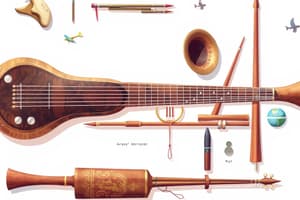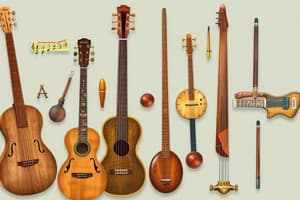Podcast
Questions and Answers
What does the Hornbostel-Sachs classification system primarily classify?
What does the Hornbostel-Sachs classification system primarily classify?
- Musical instruments (correct)
- Composers
- Musical theory concepts
- Genres of music
What are the four main categories of the Hornbostel-Sachs classification system?
What are the four main categories of the Hornbostel-Sachs classification system?
Chordophones, aerophones, membranophones, idiophones
What category of instruments do violins and guitars belong to?
What category of instruments do violins and guitars belong to?
Chordophones
What instruments are classified as aerophones?
What instruments are classified as aerophones?
Which instruments are categorized as membranophones?
Which instruments are categorized as membranophones?
What defines idiophones in the Hornbostel-Sachs classification?
What defines idiophones in the Hornbostel-Sachs classification?
What instruments are included in the electronophones category?
What instruments are included in the electronophones category?
The Hornbostel-Sachs classification system was originally published in _____
The Hornbostel-Sachs classification system was originally published in _____
Flashcards are hidden until you start studying
Study Notes
Hornbostel-Sachs Classification System
- A music instrument classification system created in 1914.
- Divides instruments into five categories: chordophones, aerophones, membranophones, idiophones, and electronophones.
- The system aids in understanding the diverse types of musical instruments across cultures.
Chordophones
- Defined as instruments with strings, which can generate sound by being plucked or bowed.
- Examples include violin, guitar, cello, and piano.
- Chordophones can vary in construction and playing techniques, influencing their sound.
Aerophones
- Classification for instruments that produce sound through vibrating air.
- Notable examples are flute, saxophone, trombone, and trumpet.
- Sound is generated by the player's breath, which creates vibrations in the air column within the instrument.
Membranophones
- Instruments that generate sound by vibrating membranes.
- These membranes can be activated by striking or rubbing.
- Common examples include drums (such as timpani and snare) and tenor drums.
Idiophones
- Category for instruments that produce sound by being directly struck, scraped, or shaken.
- Examples include cymbals, triangle, marimba, and vibraphone.
- Sound is often produced from the material itself, without the need for strings or membranes.
Electronophones
- Instruments that utilize electronic means for sound production or modification.
- This category includes synthesizers, electric violins, and electric guitars.
- Electronophones represent modern advancements in musical instrument technology, offering a wide variety of timbres and effects.
Studying That Suits You
Use AI to generate personalized quizzes and flashcards to suit your learning preferences.



